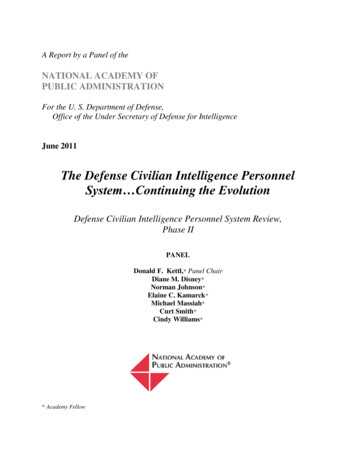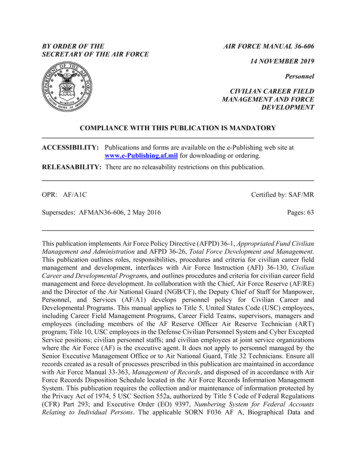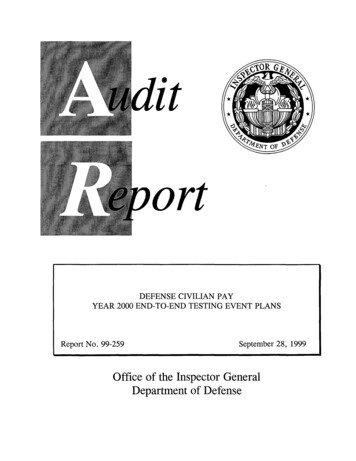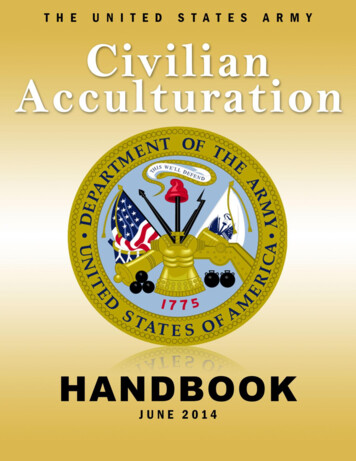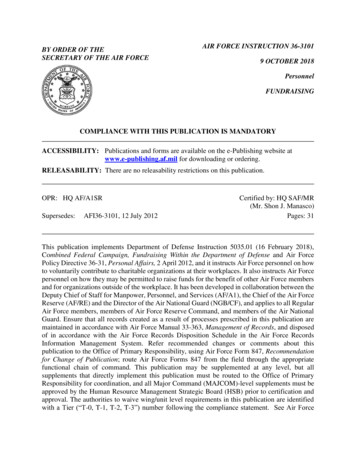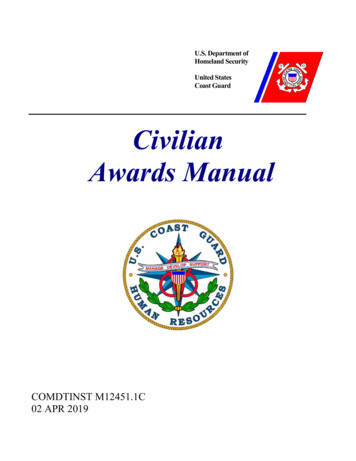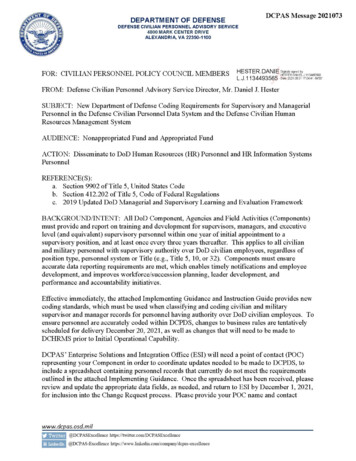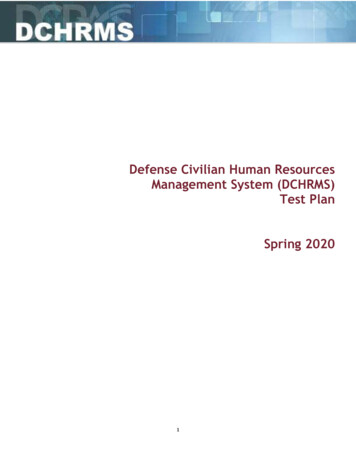
Transcription
Defense Civilian Human ResourcesManagement System (DCHRMS)Test PlanSpring 2020RATING PROCEDURE TITLEStandard Operating ProcedureJuly 20141
TABLE OF CONTENTS1.0Purpose and Background . 42.0Roles and Responsibilities . 43.0Test Methodology . 74.0User Acceptance Testing (UAT) . 12Appendix A: Baseline Capability List . 14Appendix B: Testing Working Group Members . 16Appendix C: DCHRMS Deployment Decision Criteria. 18Appendix C-1: DCHRMS Deployment Decision Criteria for DFAS . 22Appendix D: DCHRMS Interfaces . 34Appendix E: Mass Updates . 37Appendix F: Test Scenario Example . 39Appendix G: Conference Room Pilots . 40Appendix H: DCHRMS Scrum Delivery Teams . 432
3
1.0PURPOSE AND BACKGROUNDThe DoD IT Reform Management Team identified Oracle’s Cloud Human Capital Management(HCM) product as the Software as a Service (SaaS) solution intended to replace the Defense CivilianPersonnel Data System (DCPDS) as the next-generation DoD civilian personnel system. In order toensure compliance with the myriad laws and regulations that govern DoD civilian personnel,configuration of the core Oracle tool began in the fall of 2018. The Defense Civilian HumanResources Management System (DCHRMS) is HCM configured based on requirements gathered inmultiple working groups, data calls, and consultations with subject matter experts.DCHRMS is expected to establish a single employee record for all DoD civilian personnel andprovide the core capabilities needed for civilian personnel management while leveraging the costbenefits of SaaS and the operational benefits of a cloud environment. Because of the configurationneeded to incorporate Federal laws and policies into the HCM environment and the significantimpact that deploying an incomplete product could have on the DoD, this plan establishes criteriafor thorough testing to be conducted before system acceptance.1.1Plan Overview and ScopeThis plan establishes a framework for how and when DCHRMS Testing will be conducted, identifiesthe processes that should be tested, and establishes the responsibilities of the testing working group.The scope of testing is focused on the usability and functionality listed in the Baseline CapabilitiesList found in Appendix A.1.2Objective1.2.1 Primary ObjectiveTesting is conducted to ensure that the system satisfies the needs of the business as specified in thefunctional requirements and meets the capabilities from the DCHRMS Task Orders.1.2.2 Secondary ObjectiveTo identify and expose defects and associated risks, communicate all known issues to the projectteam, and ensure that as many issues as possible are addressed in an appropriate manner prior toimplementation.2.0ROLES AND RESPONSIBILITIESKeys to a successful test process involve open channels of communication, detailed documentation,and clearly defined roles and responsibilities. Each team member must function in a group settingas well as work independently for extended periods of time. Testing is largely a collaborative processand test results must be analyzed from different perspectives and by team members with variouslevels of expertise to ensure success.2.1 Testing Working GroupThe testing work group is led by the DCPAS, Enterprise and Solutions Integration (ESI) directorateand includes members of each Component who possess a thorough knowledge of the current HR4
transactional system (DCPDS), as well as the design decisions for DCHRMS. These team membersare responsible for understanding the DCHRMS requirements and building corresponding testscenarios to ensure all requirements are evaluated. Members must be detail-oriented and diligent incollecting proper documentation to support the test results. The testing working group willparticipate in recurring meetings prior to each test event to ensure all test scenarios are developedand the testing environment is prepared. Both the testing execution lead and testing resolution leadfor each component will be a part of the testing working group. The testing working group membersare the primary testers for each test event.All team members (identified in Appendix B) will be presented with an overview of the test processand what their specific role in testing is for each test event.2.2 Testing Working Group Facilitator (ESI)The testing work group facilitator is responsible for reporting on the status of DCHRMS testing to allstakeholders on a regular basis. The facilitator assigns test scenarios to Testing WG members forboth creation and execution, and serves as the primary contact point throughout the test cycle.2.3 Governance Test Review Board (GTRB)A board with representatives from each DoD Component, DMDC, DCPAS, and integrationcontractor support. The board validates defect severity, provides further clarification on defects, andidentifies mitigation plans for defects. This board is limited to one vote per Component when adecision is needed on behalf of the DoD.2.4 User Acceptance Testing (UAT)For UAT, each Component will provide additional testers in addition to the members of the TestingWorking Group. The need for additional UAT testers is to ensure there are enough resources to testeach area and function of DCHRMS and to test through the perspective of new users. Eachcomponent tester who participates in UAT will be assigned system capabilities to test by theirComponent testing execution lead. Each tester needs to thoroughly test that capability and properlydocument system defects or errors that are discovered. Prior to UAT each tester will attend aDCHRMS training course to understand how the system functions.2.4.1 UAT Testing Execution LeadDuring User Acceptance Testing, each Component will assign an execution lead who will focus onDCHRMS functionality and test scenarios assigned to the component and work with the componenttesters to make sure the component executes all assigned testing and track the pass/ fail status andassociated defects of each scenario.2.4.2 UAT Testing Resolution LeadDuring User Acceptance Testing, each Component will assign a resolution lead who should be thecomponent representative on the GTRB. This lead needs to be aware of the tickets submitted bytesters within their component and should be able to speak on behalf of them at the GTRB meetings.As tickets are resolved they will be responsible for the completion of ticket re-testing and validationof the implemented resolution.5
2.5 System IntegratorThe system integrator provides release notes of system changes and demonstration of those systemchanges in advance of each test event. They also conduct planning to define the items that will bedelivered that will need to be subsequently tested.2.6 DoD Civilian HRM Systems Technical BoardThe technical board is chaired by the Director, Enterprise Systems and Integration (DCPAS), vicechaired by the Director, Civilian Personnel Division (DMDC), and is comprised of DoD leaders (GS15 and above) from each DoD Component assigned to provide unified direction and leadership toeffectively and efficiently manage and operate the Department’s Civilian HRM Systems Portfolio.Members of this board execute actions in support of DCHRMS deployment and providerecommendations for DCHRMS system development, testing strategy, deployment, and execution ofall sustainment activities. This body reviews critical issues and makes technical recommendations tothe Decision Authority Governance Board and CPPC.2.7 Civilian Personnel Policy Council (CPPC)The CPPC is comprised of DoD HRM Executive Leadership from the Service Departments and 4 thEstate Components. They provide strategic functional guidance, civilian HR expertise, andComponent feedback in support of the DCHRMS system development, test strategy, deployment,and execution of all sustainment activities.2.8 Decision Authority Governance Board (DAGB)The Decision Authority Governance Board (DAGB) is comprised of DCHRMS Executive Leadershipwhich includes the Deputy Director of DHRA, Director of DCPAS, Director of DMDC, and the CMO'sCIO for Defense Business Systems who serve as the adjudicative authority for DCHRMS systemconfiguration, testing strategy, and deployment, activities. The DAGB adjudicates issues andelevates final decision authority to the Oversight Board as needed.2.9 DCHRMS Functional Oversight BoardThe Oversight Board makes final decisions regarding DCHRMS system implementation, testingstrategy, and execution of all sustainment activities. The Oversight Board is chaired by the DeputyAssistant Secretary of Defense, Civilian Personnel Policy and Director of the Defense HumanResources Activity and is comprised of members of the CPPC and DSAG. The Oversight Boardmakes all fiduciary decisions regarding DCHRMS deployment and sustainment activities. Inaddition, the Oversight Board will make a recommendation to the USD (P&R) on a deploymentdecision, i.e. Go/ No Go, based on results of testing and other readiness indicators.6
3.0TEST METHODOLOGYTesting will occur over multiple iterative events prior to DCHRMS deployment. Testing began withprototype testing in June 2019, and there are multiple pre-deployment test events scheduled tooccur prior to DCHRMS deployment. Beginning in the summer of 2020 these pre-deployment testevents are referred to as Conference Room Pilots (CRP); additional information about the CRPprocess is located in Appendix G. Testing will then culminate with User Acceptance Testing (UAT).Testing will be carried out primarily by the end users (i.e. Component Subject Matter Experts) whowill execute the DCHRMS test scenarios referenced in section 3.4.2. As the schedule allows, usersshould also perform additional tests not detailed in the plan that are within the scope of the project.Testing progress will be tracked based on the percentage of executed test scenarios, the resolution ofCategory I and Category II defects (see section 3.5.2), and other relevant testing activities.Users will report issues and defects identified during testing to the DCHRMS testing working groupfor documentation and escalation as they are identified. These incidents will be described,prioritized, and tracked by using screen captures, descriptions, and steps necessary for the systemintegrator to reproduce the defect. Information on defect prioritization can be found in section3.5.2.3.1Testing ActivitiesCore Testing activities and deliverables are defined below: Identify Testing Working Group –SMEs who will take part in testing and testing relatedactivities leading up to DCHRMS deployment. This includes identifying the testing executionand testing resolution lead for each component. Members of this working group are identifiedin Appendix B.Develop Test Scenarios – Test plans to make sure functionality of the application is workingas expected. Each test scenario will tie back to a Baseline Capability identified in Appendix Aor an existing Jira ticket, and measure actual results against expected results. When scenariosare executed, testers will document the criteria used to complete the scenario and give apass/fail outcome. For UAT, test plans ensure that end-to-end functionality of the applicationis working.o For each scenario, testing criteria needs to include impacted communities, pay plans,locations, servicing Components, pay schedules (i.e. frequency), and other variablesassociated with the capabilityTest Scenario Review – Review by the Testing WG prior to each test event.Conference Room Pilot - DCHRMS event consisting of system demonstrations and hands-ontesting with participation from the DoD components to verify the scope of the previous scrumhas been deliveredDCHRMS Environment Validation – Validation of connectivity and appropriate record sets inthe test environment for each end user participating in testing.Test Scenario Execution - Completion of all test scenarios by DoD testers.Defect Tracking – Defects will be entered and tracked via email and inputted into Jira by thesystem integrator. Each entry will include detailed information about each defect (i.e. userrole, screen, system capability, description of issue, data element (if applicable), severity, test7
scenario). During meetings of the Governance Test Review Board, defect severity will beevaluated.3.2Test Schedule and CycleThere will be a test event for each Conference Room Pilot (CRP) that is a part of the pre-deploymenttask order(s) leading up to the deployment of DCHRMS. These CRPs will incorporate changes to thesystem including quarterly Oracle releases, additional system configurations, and resolution ofdefects. The table below provides the test events that are scheduled to occur prior to DFASdeployment:EventCRP 1CRP(s) 2 – n*Event Dates6/29 – 7/5 (tentative – may need to be adjusted toavoid holiday overlap)TBDUAT Tester TrainingTBDUser AcceptanceTesting (UAT) – DFASDeploymentTBD*The number of CRPs needed is being determined.After DCHRMS is deployed for DFAS, there will be additional CRPs in preparation for thedeployment of the other DoD components.The main objective of the CRP test events is to ensure system changes leading up to UAT areimplemented and functioning correctly. Each CRP test event allows the DoD to validate that systemchanges delivered during each of the scrums meet the DoD’s requirements. The scrum deliveryteams will define the scope and functionality included for validation during each CRP. The scrumdelivery teams are listed in Appendix H.3.3Test PrinciplesIn order to succeed, preparation for testing and the testing itself will be conducted while adhering tothe following principles: 3.4Testing will be focused on meeting key performance parameters and functional requirementsThere will be common, consistent procedures for all teams supporting testing activitiesTesting processes will be well defined, yet flexible, with the ability to change as neededTesting environment and data will emulate the production environmentTesting will be a repeatable, quantifiable, and measurable activityPre-Test ActivitiesPrior to each test event, the system integrator provides the system configuration release notes thatoutline the changes that have been made to the system since the previous test event. The release8
notes will guide the development of test scenarios to address the new system configurations. Theparticipants of the test events include DCPAS, DMDC, and the DoD Components. Each Componentshall provide at least two of the participants who have prior experience with DCHRMS and havebeen involved in previous testing and/or design workshops. A third participant may be a part of theComponent’s training team and attending to determine the best methods to develop DCHRMStraining materials; their participation may depend on the content delivered.Prior to each test event, the system integrator needs to provide the DoD with the process areas/baseline capability that the new configurations address, updated test cases that correlate with eachnew configuration, release notes, a system walk-through/ demo of the new configurations, and othermaterials to assist the testers. The duration and location of each test event will be determined priorto the event commences but may need to be adjusted.Prior to each test event, DoD Components will be assigned areas for testing (i.e. Nature of Actioncodes, work structure capabilities, manager self-service), test scenarios that they will be responsiblefor testing, and if necessary, items for re-testing. This ensures that DCHRMS is comprehensivelytested during each test event. Testing criteria will be identified and test scenarios created by theTesting WG before test execution begins. Prior to each test event, new DoD test participants shouldbe trained on DCHRMS to gain an understanding and familiarity with the system.3.4.1 Test EnvironmentApplicable IP addresses and URLs will be provided to the Testing WG and all workstations should beconfigured appropriately for access to the test environment. Each test participant will be providedaccess to all applications within the defined scope of testing. The tester will log in and validate thecorrect menus, permissions, and general access are available.Access to test data is a vital component in conducting a comprehensive test of the system. All testingparticipants will require usage of test accounts and other pertinent test data which should beprovided by the system integrator. Test environment will include data for appropriated fund, nonappropriated fund, local nationals, country or location specific, acquisition demo, lab demo, DCIPS,and other unique personnel systems. All user roles should fully emulate production. Completion ofan access request form may be required in order to create test accounts.3.4.2 Test ScenariosTest scenarios provide a high-level description of the functionality to be tested and may include adetailed script for testers to follow. Each test scenario contains the following: baseline capability orJira ticket being tested, test description, business rules (if applicable), tester, user role , action to beperformed, test data to be utilized, expected results, error descriptions (if applicable), pass/failresults, date tested, screenshots (if applicable for replication) and any additional comments from thetester. Each test scenario will reference a specific functional requirement from the BaselineCapability List (Appendix A) or an existing Jira ticket, and each individual test scenario for thatcapability will be given a Pass/Fail score. Appendix F displays an example of a Test Scenario.The testing Execution Leads will identify the test scenarios for the Baseline Capabilities and Jiratickets assigned to testers, and testers will identify the impacted employee records and/or positionsthat need to be tested for each scenario. Test scenarios will address records for appropriated fund,9
non-appropriated fund, local nationals, country or location specific, acquisition demo, lab demo,DCIPS, and other unique personnel systems.3.5Test ActivitiesMembers of the Testing WG and other identified SMEs will perform testing following the processoutlined below and document pass/fail results for each scenario. Each DoD Component will need totrack the pass/fail status of each test scenario and the associated tickets. Throughout the test event,progress will be periodically monitored. If an existing ticket exists for an item being tested, the testerwill provide feedback that the ticket was re-tested along with the pass/fail status. Tickets submittedduring each test event due to system defects need to be resolved by the system integrator and retested within the test event window. Any failures or defects discovered during testing will be raisedas per severity guidelines along with steps detailing how to simulate the result (as well asaccompanying screenshots if appropriate).Testing determines if the system baseline capabilities have been delivered, or for each test event,such as a CRP, if the specified content determined has been delivered. Another major objective oftesting is to identify and resolve all regulatory and critical gaps, to include the category I defects, andmost category II defects. It is expected that some work-arounds will need to be identified andincorporated, however previously incorporated work-arounds should be removed as updated systemconfigurations are implemented. System performance related to process efficiency and overallusability will be evaluated throughout testing.During each test event the Governance Test Review Board (GTRB) will convene to review newdefects that have been identified, assign a severity level (CAT I, II, III, IV) to the defects, andevaluate the mitigation strategy of each defect.Each test event will aim to accomplish the following goals:1.2.3.4.Validate system changes meet the DoD’s requirementsIdentify defects and gaps in DCHRMSResolve defects – primary focus on CAT I and II defectsRe-test and validate each defect is resolved – including all CAT I and II defectsExecute testscenarioMark testscenario asPass/FailElevatedefects offailed testscenariosReport failedtest scenarios3.5.1 Validation and Defect Management10If neededprovide furtherexplanation offailedscenarios/defectsAfter defect isfixed retestfailed testscenario
It is necessary that collectively DoD testers execute all test scenarios. However testers should also doadditional testing if they identify a possible gap in the test scenarios. If a gap is identified, thecorresponding test scenarios will be updated to test the gap.Elevatedefects offailed testscenariosThe defects will be submitted via email and logged into Jira by the system integrator. During testevents, the system integrator will provide daily reports on submitted defects for discussion with theGovernance Test Review Board (GTRB). The GTRB is a body consisting of a representative fromeach DoD Component, DCPAS, DMDC, and the system integrator. This body monitors the progressof testing and review defects, and if needed finalizes defect prioritization. The system integrator willwork to create fixes to identified defects during the testing cycle when possible, and will notify endusers when a submitted defect is fixed for re-testing by that user.It is the responsibility of the tester to report the defects, link them to the corresponding test scenario,assign an initial severity, retest after the defect is fixed, and confirm the defect is closed; it is theresponsibility of the Testing WG facilitator to review the severity of the defects and coordinate withthe system integrator on the fix and its implementation, communicate with testers when the test cancontinue, request the tester retest, and modify status as the defect progresses through the cycle; it isthe responsibility of the system integrator to review defects, ask for details if necessary, fix thedefect, and communicate to the GTRB when the fix is complete and implemented.3.5.2 Defect PrioritizationThe Testing WG facilitator and the GTRB will function as a liaison between the Testing workinggroup/ Component testers and the system integrator on matters of prioritizing and classifyingdefects. Defects found during testing can be assigned one of four levels of severity and one of threelevels of impact. A total score for each defect will be determined by multiplying the Severity scoreand the Impact score:SeverityDefinitionPointValueCAT-I Critical Severity: Failure to meet approved design decision/ requirement: Noworkaround4CAT-II High Severity: Failure to meet approved design decision/ requirement:Workaround identified but adds increased workload or increases risk Moderate: Failure to meet approved design decision/ requirement: Workaroundhas minimal impact3 Low Severity: Non-critical design decision / requirement.1CAT-IIICAT - IVImpactDefinition2PointValueImpact-1 System: Affects all Components and communities in DCHRMS6Impact-2 Group: Affects a specific Component (e.g., Army, AF, Navy) or effects a specificcommunity (e.g. NAF, LN, Demo, SES)5Impact-3 User: Affects a specific individual411
Defect LifecycleDefects must be clearly captured and escalated to ensure prompt resolution by the system integrator.Each defect submitted by testers will be assigned a severity level by the tester, assigned an impactlevel by the system integrator, resolved by the system integrator, and re-tested prior to closure. Thefollowing is a snapshot of the standard defect lifecycle:Tester SubmitsDefectDefect AssignedSeverity and ImpactDefect Triaged byDev TeamDefect Resolved byDev TeamResolutionVerified byTesterNoYesDefect Closed byGTRB3.6Post-Test ActivitiesFollowing the completion of the test event, the GTRB will continue to meet bi-weekly to addressitems in the defect backlog. As defects in the backlog are resolved, the tester who submitted theticket must re-test to validate the defect was resolved. Some issues found during testing may requireconfiguration changes; if the DoD determines a configuration change is necessary, the issue must bere-tested after the configuration change is implemented.The DoD components may also need to continue to test during the interim time periods between testevents and continue to submit tickets as defects are discovered. As new defects are identified theywill also be addressed during the GTRB meetings. This continuous testing and meeting of the GTRBallows the DoD to constantly address issues in the defect backlog and make the necessary fixes toDCHRMS leading up to deployment.[TBD – how section 3.6 relates to the CRPs]4.0USER ACCEPTANCE TESTING (UAT)Prior to UAT, using the Baseline Capability List found in Appendix A, each DoD Component will beassigned a list of system capabilities that they will be responsible for testing and tracking the resultsof testing. This will ensure that each capability is thoroughly tested and no area of the system isoverlooked. Each system capability will be tested using various criteria, such as pay plans, locations,business units, and organizations. The Component testing lead(s) will work with the otherComponent testing representatives to identify the criteria for each capability they are assigned.12
Since some capabilities have different processes based on the user community (i.e. non-appropriatedor National Guard) and since there will be approximately 10 testers per Component participating inUAT, Component testers may need to work with testers from other Components.The main objective of UAT is to assess if system functionality meets the requirements set forth by theDoD and to ultimately make a determination on the functional readiness of DCHMRS. At theconclusion of UAT, the DoD will determine if the viable product requirements in Appendix C havebeen delivered, and if the system is ready for deployment. A recommendation for deployment will beprovided by the GTRB through governance to the Functional Oversight Board.Each DoD Component will provide up to 10 testers to participate in UAT. Prior to the beginning ofUAT, each tester will need to attend a DCHRMS training course. This course is scheduled to occur inApril 2020. In addition, the records available in the UAT environment must reflect every type ofexisting record in DCPDS.Elevatedefects offailed testscenariosMark testscenario asPass/Fail13
APPENDIX A: BASELINE CAPABILITY LISTThis table will need to be updated if new DCHRMS Task Orders incorporate additional baselinecapabilities. For the items listed below complete functionality includes, but is not limited to,associated business rules, incorporation into the correction and cancellation process, individualcompensation plans, and the ability to execute mass updates.Process AreaManage WorkStructures byHRManage Personby HRManageEmployment byHRAppendix A - Baseline Capability Manage Enterprise Manage Legal Entities Manage Business Units Manage Departments Manage Work Locations Manage Jobs Manage Job Families Manage Grades Manage Grade Rates Manage Positions Manage Organization Trees Manage Divisions Change Name Change Address Change Email and Phone Change Marital Status Manage Biographical Info Manage National Identifiers Manage Disabilities Upload Documents (Up to 5 distinct documents) Manage Emergency Contacts Manage Talent Profile Transfer Promotion Position Change Legal Entity Transfer Manager Change Manage Direct Reports Location Change Working Hours Change Mass Updates Suspend Assignment Temporary Assignment Grade Step Progression Probation Periods Demotion End Assignment Global Transfer Out of Country Global Temporary Assignment Manage Areas of Responsibility14
Process AreaAppendix A - Baseline CapabilityManage WorkRelationshipby HR Hire Termination Rehire Adding a Non worker Add a Pending WorkerManageCompensationby HR Change Salary Mass Salary Updates Manage Payroll ElementsManage Payrollby HR Manage Payroll Relationship (e.g., Payroll Period)Manager andEmployee SelfService Manager Self Service Transfer, Promotion, Location Change, Working HoursChange, Position Change, Termination, Manage Salary andView Compensation History Employee Self Service Change Name, Change Address, Change Email & Phone,Change Marital Status, Manage Biographical Info, ManageNational Identifiers, Manage Disabilities, EmploymentVerificationDCHRMS Baseline Capabilities includes functioning and accurate system interfaces with theinterface partners listed in Appendix D.15
APPENDIX B: TESTING WORKING GROUP MEMBERSNameComponentProjectRoleE-mailRyan .milEric GregoryDCPASJeanette DeschampsDCPAS/ DCHRMSProject LeadPrimaryjeanette.m.deschamps.civ@mail.milCindy BeesonDCPAS/ DCHRMSProject Co-LeadPrimarycindy.s.beeson.civ@mail.milMike PridemoreDoNPrimarymichael.pridemore@navy.milJanet HernandezDoNjanet.hernandez@navy.milJaqueline BoyleDoNjacqueline.boyle@navy.milPatricia GalindoAF NAFShalanda SimsAF NAFshalanda.sims.1@us.af.milAda BookerAF NAFada.booker@us.af.milKimberly MarshallNGKevi
(HCM) product as the Software as a Service (SaaS) solution intended to replace the Defense Civilian Personnel Data System (DCPDS) as the next-generation DoD civilian personnel system. In order to ensure compliance with the myriad laws and regulations that govern DoD civilian personnel, configuration of the core Oracle tool began in the fall of .
